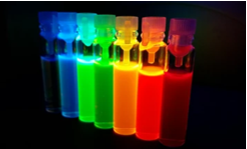Introduction
Quantum dots (QDs) are nanoscale semiconductor particles with different optical and electronic properties from larger light-emitting diode particles. The electrons in a QD absorb energy and break away from the atom, creating a conductivity band. When these electrons fall back into the valence band they will emit different light. The color of light depends on the energy difference between the conductance and valence bands. Due to their highly tunable properties, QDs have received widespread attention. Their potential applications include transistors, solar cells, light emitting diodes, diode lasers and second harmonic generation, quantum computing, medical imaging and so on.
 Fig.1 Different emission lights by QDs of different sizes
Fig.1 Different emission lights by QDs of different sizes
Synthesis method
In the research process of quantum dots, the preparation method is particularly important, which can directly determine the silver optical efficiency and other properties of quantum dots. Therefore, it is urgent to explore a more convenient synthesis method, strengthen the surface modification of quantum dots, so as to break the limitation of their preparation. At present, the preparation methods of quantum dots can be roughly divided into organic phase synthesis, aqueous phase synthesis, microemulsion synthesis and so on.
- Organic phase synthesis: Organometallic precursor is usually added to the ligand solution at high temperature. Under the condition of high temperature, organometallic precursor will rapidly pyrolysis and nucleate, and QDs are formed by slow growth of the crystal nucleus generated by pyrolysis. The QDs synthesized by organic phase have high fluorescence yield and good dispersion, and many methods have been commercialized. However, its high toxicity and poor water solubility limit its application in the field of biological detection.
 Fig.2 Oil-soluble CdSe/ZnS QDs
Fig.2 Oil-soluble CdSe/ZnS QDs
- Water phase synthesis: Quantum water-phase synthesis methods mainly include traditional water-phase synthesis method, hydrothermal method, micro-micro-assisted hydrothermal method and light-assisted synthesis, etc. Among them, hydrothermal method is one of the most commonly used methods, that is, in a sealed pressure vessel, with water as the solvent, chemical reaction under high temperature and high pressure. The nanoparticle prepared by hydrothermal method has the characteristics of high purity, good dispersion and crystal shape, low synthesis cost, less environmental pollution and easy industrialization. In order to improve the luminescence efficiency of QDs and reduce the toxicity of QDs, the preparation of core-shell structure of water-soluble QDs is also an important method.
 Fig.3 Schematic diagram of quantum dots synthesis in the nuclear shell of CdTe/CdS/ZnS and CdTe/CdS/ZnS [1]
Fig.3 Schematic diagram of quantum dots synthesis in the nuclear shell of CdTe/CdS/ZnS and CdTe/CdS/ZnS [1]
- Microemulsion synthesis: In microemulsions, incompatible continuums are separated by the parent molecules of the surfactant to form extremely small Spaces, like "microreactors". In these microreactors, reactants are added to undergo chemical reactions, resulting in products that can be controlled at the nanoscale. The particle size of the QDs prepared by this method can be adjusted according to the concentration ratio of the reactants added.
Alfa Chemistry provides various types of QDs, including cadmium-based QDs, cadmium-free QDs, perovskite QDs and other types of QDs and related services, please contact us if you have any need.
Reference
- Anirban Samanta.; et al, Aqueous Synthesis of Glutathione-Capped CdTe/CdS/ZnS and CdTe/ CdSe/ZnS Core/Shell/Shell Nanocrystal Heterostructures. Langmuir, 2012, 28, 8205−8215.


 Fig.1 Different emission lights by QDs of different sizes
Fig.1 Different emission lights by QDs of different sizes Fig.2 Oil-soluble CdSe/ZnS QDs
Fig.2 Oil-soluble CdSe/ZnS QDs Fig.3 Schematic diagram of quantum dots synthesis in the nuclear shell of CdTe/CdS/ZnS and CdTe/CdS/ZnS [1]
Fig.3 Schematic diagram of quantum dots synthesis in the nuclear shell of CdTe/CdS/ZnS and CdTe/CdS/ZnS [1]